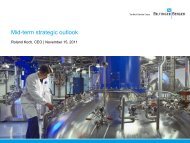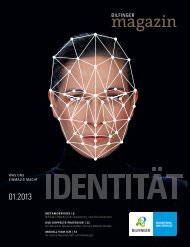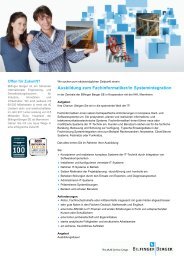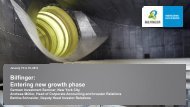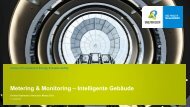PDF Download Issue 2-2013 - Bilfinger
PDF Download Issue 2-2013 - Bilfinger
PDF Download Issue 2-2013 - Bilfinger
Create successful ePaper yourself
Turn your PDF publications into a flip-book with our unique Google optimized e-Paper software.
24BILFINGERMAGAZINE02.<strong>2013</strong>325nourish and cherish fungus cultures inside theirnests and feed on them. Other social insects besidesleafcutter ants, such as some species of termites, havealso made the transition from a hunter-gatherer existenceto a reliance on agriculture. But leafcutter antsof the genera Atta and Acromyrmex farm in such anadvanced manner as to achieve something entomologistBert Hölldobler calls “ecological dominance”: obviouscontrol over their environment.While most of the 230 fungus-farming species ofants native to South and Central America use rottenleaf matter and dead organic material as fertilizer, 45species, including Atta and Acromyrmex, went over tofeeding the fungus fresh leaves some ten millionyears ago. In doing so, both the fungus and the antstapped into an incomparably higher nutrient density,which saw their colonies grow to several million individualsin the course of an evolutionary leap. “Thisleap forward is definitely comparable with that of thehuman race when we learned to control fire and beganto cook our food, giving ourselves access to amuch wider range of vitamins and minerals,” says biologistMorten Schiøtt from the University of Copenhagen’sCenter for Social Evolution.Schiøtt and his fellow scientist, Henrik De FineLicht, have decoded some parts of the complex chemicalprocesses that take place when a fungus is fedwith fresh leaf matter: the fungus grows like blackbread mold on the substrate of leaf remnants, displayinga multitude of tube-like structures somewhatsimilar to a bath sponge. The leaf fragments broughtby the ants would actually be inedible to the fungus:particularly the phenols contained in the leaves andresponsible for defending them against natural enemieswould damage and ultimately spoil it. That’s if itweren’t for the enzymes that the fungus actually haswithin itself, just not in the right place. The enzymerichfungus cells are in fact found in the tips of thehypha, thread-like cells that grow within the substrate.The ants get inside the substrate through the tubelikecorridors, where they then eat these cells, takingthe enzymes inside them ready for depositing on thefreshly cut leaf matter back at the surface. This ishow the ants make the leaves edible to the fungi.PERFECT WASTE MANAGEMENTScientists compare this fascinating process withbioreactors, in which humans use enzymes to breakdown organic matter to produce ethanol and othersubstances. Incidentally, most Atta species even buildspecial waste chambers for the depleted substrate leftbehind by the fungus, though these take up an evergreatervolume of the nest as time goes on. Therefore,Atta colombica has made the transition to disposingof the material outside of the nest – indicating thatleafcutter ants would also seem to know a thing ortwo about sustainable waste management. |The fungus grows on the substrate of leaffragments like mold on a piece of bread.Photos 22-25 Wolfgang Thaler, Kevin Schafer/Corbis, Ralph Clevenger/Corbis, Okapia KG, GermanyThe ants deposit the enzymes on the leaf fragmentson the surface of the fungus farms with their excrement.The enzymes break down the toxins in the leaves and makethem edible to the fungus.2The ants eat enzyme-richfungus cells inside the spongelikestructure of the substrate.1The fungus cultures grow on a substrate ofleaf remnants inside chambers in the nest. Theants deposit fresh leaf fragments on the surfaceof the fungus farms.THE FUNGUS FARMS



